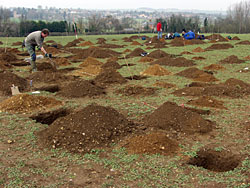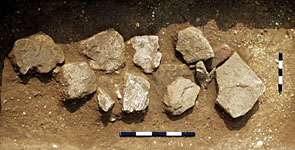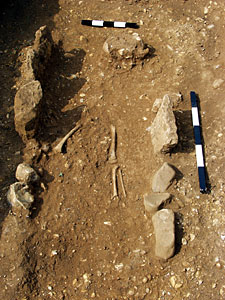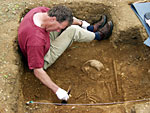| In March 2004 we undertook an exploratory test pitting of the site to try and locate the extent of the cemetery and to ascertain the potential extent of the remains.
Our investigation revealed several potential burials within close proximity to one another and in a relatively small and well-defined area. This meant that the cemetery was probably quite small and that there would have been few internments. Given this fact, and the pressing need to undertake some fieldwork to alleviate the threat from ploughing, a full excavation of the remains was carried out on the 27th and 28th May.
|

March 2004 |
|
May 2004
Six burials were excavated in various states of preservation. One grave was well preserved and still had its stone capping in place whilst in another only the lower portion of the legs of the individual survived.

Grave 5: stone capping
All of the graves where aligned east-west, which is a Christian rite; however the more intact burials contained grave goods, which is associated with pagan rites. The carbon date from the Whitehall Warrior, excavated from this same site earlier, suggests a 7th century date and this places the burial ground at the right time in history for the conversion of these people to Christianity.
The graves had been carefully laid out in a single continuous row and probably represent a small family group covering one or two generations. Amongst the skeletons is a body of a woman, two males, an adolescent and a baby. The evidence affirms the family aspect to the burial group and the grave goods reflect the relative status of the different individuals. The woman was buried with personal items of jewellery and domestic items of a culinary nature, while one of the male skeletons had a spear. All the adults were buried with their personal knife.
The positions of the skeletons suggest the internments were covered with shrouds before being laid to rest and there was no evidence of wooden coffins being used. Northants Archaeology is currently examining the skeletons - their findings will be published here. Every skeleton will be carbon dated and further tests on their DNA will be carried out.
After studying the skeletons we hope that the bones will be reburied in a secure and respectful location on the farm.
|

May 2004 (viewed from the north).
Grave 3 - the baby burial - is beyond the
top frame of this photo,
separated from the other burials

Grave 6: adolescent burial
|

